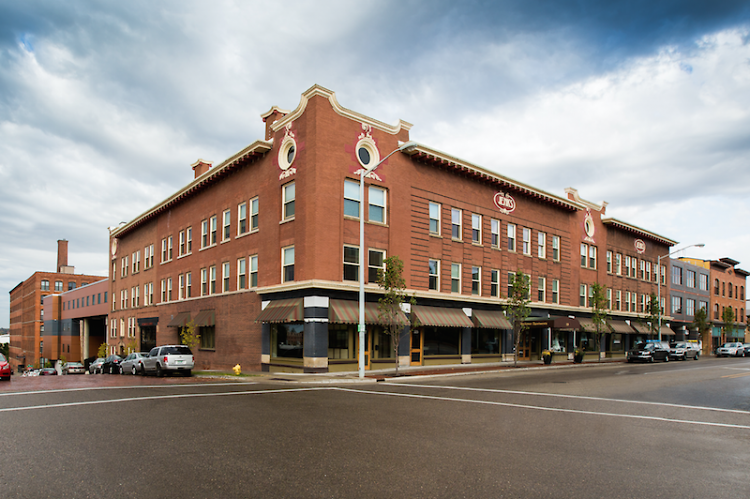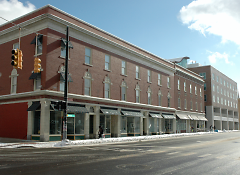On December 29, an article entitled “Local urban sociology professor explains concerns about Heartside, gentrification” appeared in The Rapidian that requires a response.
The article suggests that development in the Heartside Neighborhood will result in the “poor residents being forced out.” The article deserves a response because the author and others were apparently unaware of some unique conditions within the Heartside Neighborhood that will make the potential for large scale displacement of low income households in the Heartside Neighborhood very unlikely.
First and foremost is the fact that there are now more “affordable” housing units in this neighborhood than at any time in the city's history. Even more important is the fact that all of these newer “affordable” units carry federal and state mandated “rent and income restrictions” limiting how high the rents can be and restricting occupancy to households within certain income limitations. These units are also encumbered with deed restrictions, mandated by government, which typically require the owner to maintain the “rent and income restrictions” for a minimum of 30 years. Owners have agreed to these restrictions in return for public financing to support the development of these apartment communities.
Dwelling Place alone owns 730 “affordable” rental units within the Heartside Neighborhood, all of which carry the rent, income and deed restrictions mentioned earlier. Some of these units serve low income working households, including artists, while many others are serving disabled, elderly and formerly homeless households. Beyond the work that we have done, there are several for-profit developers who specialize in affordable housing development that have added several hundred apartments in this neighborhood, also subject to these restrictions.
It is also true that Dwelling Place was instrumental in working towards changing public perception of Division Avenue and the neighborhood by developing and continuing to sponsor many of the artist live/work spaces that are now located throughout the area. We are the very proud sponsor of the Avenue for the Arts Program which provides support for area artists, promoting their work and the contributions they make towards economic development in the neighborhood and downtown. The artist live/work units we own are targeting mostly lower income artists and will continue to do so for many years to come, regardless with what else happens in the neighborhood.
We were also early supporters of the Van Andel Arena, the Entertainment District, the Heartside and Peckich Parks, the Division Avenue Main Street program, the Heartside Planning Coalition and many other reinvestment strategies. These initiatives have all contributed to improving quality of life in a neighborhood that was once one of the most dilapidated and economically depressed neighborhoods in the city.
A neighborhood that can support a variety of uses is always going to be a healthier neighborhood, in part because of the jobs and amenities that it can offer to the residents who live there, regardless of their income.
In the many decades preceding Dwelling Place’s introduction of “rent and income restricted” housing into this neighborhood in the 1980s, the several “welfare hotels” and other rooming houses operating at that time were the only permanent housing options available for low income households. Saying nothing about the dilapidated conditions that were often present in many of these older buildings, none carried any governmental requirements for maintaining affordability nor were the units subject to any form of deed restriction which would have prevented their sale for uses other than affordable housing. Today, the Heartside Neighborhood is in a much better position and fully prepared to welcome the many positive changes that come with economic development and increased residential density while still being able to avoid the physical displacement that has accompanied gentrification in many other neighborhoods.
For 35 years, a large majority of low income residents who live in our properties have been vocal about what they see as indifference to nuisance behaviours in this neighborhood: issues that were ignored just because it was "Heartside" with its mostly low income residents. The concerns about safety and quality of life are not just values held by artists and higher income renters moving into the neighborhood. Increased residential density results in an increase in pedestrian traffic, subsequent increases in business activity and more eyes and ears in what once were vacant buildings. The heightened awareness and concerns about nuisance behaviors are primarily a result of these changes.
Rather than blaming outside forces for imagined displacement, let’s recognize the challenges that we do have with some segments of the population including drunken bar patrons of all incomes, non-resident drug dealers preying on neighborhood residents and a small segment of the homeless population whose untreated addictions and mental illnesses have sometimes caused conflict between neighbors. Let’s work towards ensuring that affordable housing with some permanence is available in every neighborhood; that meaningful funding is available for “neighborhood” policing, social services and especially for mental health and substance abuse programs that meet and engage with people where they live, work and play. In so doing perhaps we can be more strategic about where and how critical neighborhood services are delivered to achieve the greatest impact for those who need these services while at the same time embracing comprehensive economic development.
Everyone involved in the continuing evolution of the Heartside neighborhood should understand its history and consider a new narrative. Because of the early intervention that began in the 1980’s supported by public policy that mandated long term affordability, preservation of affordable housing and economic development, are not mutually exclusive outcomes. Diversity of income, people and land use can contribute to a healthier neighborhood and a higher quality of life for everyone.
Finally, let’s also do a little better research of the facts before contributing to a gentrification narrative that is just not accurate, at least not in the Heartside Neighborhood.
Dwelling Place provides 1,108 units of low, affordable, and market rate housing in West Michigan with 730 units located in Heartside and 332 along the South Division Corridor. Both pictured apartment communities, Verne Barry Place and the Herkimer Division Apartments, are examples of affordable housing created as a home for those who are most recently homeless. To clarify: “Rent and income restricted” refers to a government restriction, usually enforced by a deed restriction on the property, which requires the owner, in return for public financing, to limit the amount of rents charged for a specified period of time (usually 15 – 30 years).Owners are also required to rent only to households who meet federally eligibility definitions, with income being just one of those criteria. Households with incomes below 50% and 60% of the area median are qualified for many of these housing programs. In Kent County 50% and 60% of the area median income for a single person household is $22,400 and $26,880 respectively.
The Rapidian, a program of the 501(c)3 nonprofit Community Media Center, relies on the community’s support to help cover the cost of training reporters and publishing content.
We need your help.
If each of our readers and content creators who values this community platform help support its creation and maintenance, The Rapidian can continue to educate and facilitate a conversation around issues for years to come.
Please support The Rapidian and make a contribution today.



Comments
Thank you Denny, for interjecting some factual information into a conversation that has been fueled by exterior perceptions instead of reality. People forget, or were not here, when much of GRs urban core was merely boarded up.